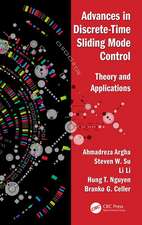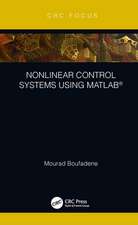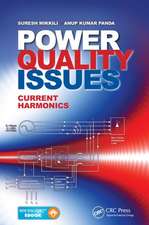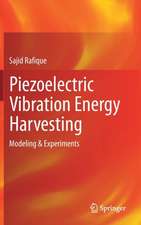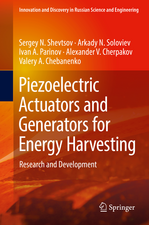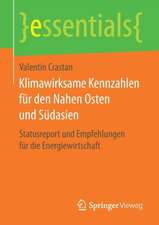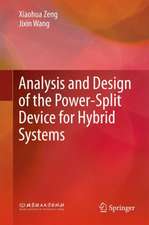High Voltage Engineering
Autor Farouk A.M. Rizk, Giao N. Trinhen Limba Engleză Paperback – 29 mar 2017
Presenting information critical to the design, selection, testing, maintenance, and operation of a myriad of high-voltage power equipment, this must-have text:
- Discusses power system overvoltages, electric field calculation, and statistical analysis of ionization and breakdown phenomena essential for proper planning and interpretation of high-voltage tests
- Considers the breakdown of gases (SF6), liquids (insulating oil), solids, and composite materials, as well as the breakdown characteristics of long air gaps
- Describes insulation systems currently used in high-voltage engineering, including air insulation and insulators in overhead power transmission lines, gas-insulated substation (GIS) and cables, oil-paper insulation in power transformers, paper-oil insulation in high-voltage cables, and polymer insulation in cables
- Examines contemporary practices in insulation coordination in association with the International Electrotechnical Commission (IEC) definition and the latest standards
- Explores high-voltage testing and measuring techniques, from generation of test voltages to digital measuring methods
| Toate formatele și edițiile | Preț | Express |
|---|---|---|
| Paperback (1) | 585.27 lei 43-57 zile | |
| CRC Press – 29 mar 2017 | 585.27 lei 43-57 zile | |
| Hardback (1) | 1581.11 lei 43-57 zile | |
| CRC Press – 4 apr 2014 | 1581.11 lei 43-57 zile |
Preț: 585.27 lei
Preț vechi: 688.56 lei
-15% Nou
Puncte Express: 878
Preț estimativ în valută:
111.99€ • 117.24$ • 92.67£
111.99€ • 117.24$ • 92.67£
Carte tipărită la comandă
Livrare economică 07-21 aprilie
Preluare comenzi: 021 569.72.76
Specificații
ISBN-13: 9781138071568
ISBN-10: 1138071560
Pagini: 801
Ilustrații: 1601; 84 Tables, black and white; 591 Illustrations, black and white
Dimensiuni: 178 x 254 x 50 mm
Greutate: 0.45 kg
Ediția:1
Editura: CRC Press
Colecția CRC Press
ISBN-10: 1138071560
Pagini: 801
Ilustrații: 1601; 84 Tables, black and white; 591 Illustrations, black and white
Dimensiuni: 178 x 254 x 50 mm
Greutate: 0.45 kg
Ediția:1
Editura: CRC Press
Colecția CRC Press
Cuprins
Insulation Stress: Power System Overvoltages. Electric Field Calculation. Statistical Analysis. Insulation Strength: Electric Breakdown of Gases. Breakdown Characteristics of Long Air Gaps. Electric Breakdown in Liquids. Electric Breakdown in Solids and Composite Materials. Applications: Overhead Lines. Lightning Protection. High-Voltage Transmission Line Insulators. Underground Cables. Power Transformers. Insulation Coordination. High-Voltage Testing and Measuring Techniques.
Notă biografică
Farouk A.M. Rizk holds a BS and MS from Cairo University, Egypt; a Ph.D from the Royal Institute of Technology, Stockholm, Sweden; and a doctorate of technology from Chalmers University of Technology, Gothenburg, Sweden. He has worked with ASEA (ABB), Sweden; the Egyptian Electricity Authority; and the Institut de Recherche d'Hydro-Quebec, Varennes, Canada. As international chairman of IEC TC 28: Insulation Coordination, he made major contributions to standardization. An elected IEEE fellow for contributions to the science of high-voltage technology and for technical leadership in the advancement of the electric power industry, many times awarded, and a CIGRE distinguished member, he is currently president of Lightning Electrotechnologies, Inc. and Expodev, Inc., both in Montreal, Quebec, Canada. His research covers many topics in high-voltage and high-power engineering.
Giao N. Trinh holds a BS and Ph.D from Laval University, Quebec City, Quebec, Canada. He has worked with the Institut de Recherche d'Hydro-Quebec, Varennes, Canada and Ecole Polytechnique de Montreal, Quebec, Canada. He holds two patents and is the author or co-author of many technical papers in the areas of corona and partial-discharge phenomena, high voltage testing, and liquid, solid, and gaseous power equipment insulation. An elected IEEE fellow for contributions to the understanding of dielectric and arc phenomena in gas-insulated cables and PES, and a DEIS member, he received a Prize Paper Award from the Substation Committee for his work on the assessment of the risk of burn-through of gas-insulated cables.
Giao N. Trinh holds a BS and Ph.D from Laval University, Quebec City, Quebec, Canada. He has worked with the Institut de Recherche d'Hydro-Quebec, Varennes, Canada and Ecole Polytechnique de Montreal, Quebec, Canada. He holds two patents and is the author or co-author of many technical papers in the areas of corona and partial-discharge phenomena, high voltage testing, and liquid, solid, and gaseous power equipment insulation. An elected IEEE fellow for contributions to the understanding of dielectric and arc phenomena in gas-insulated cables and PES, and a DEIS member, he received a Prize Paper Award from the Substation Committee for his work on the assessment of the risk of burn-through of gas-insulated cables.
Recenzii
"The most comprehensive and in-depth presentation of all aspects of HV engineering. ... The rigor and thoroughness with which the different topics are presented in the book reflect the vast experience of the authors and the significant contributions they have made to HV engineering."
—P. Sarma Maruvada, from IEEE Power and Energy Magazine, November/December 2015
"The best part of this book is that it contains numerous experimental results gathered from many references over the past two decades that pertain to high voltage breakdown and related phenomena. It is very convenient to have all this type of data in one handy reference book. Power engineers and those who design power distribution systems with regard to the power components will find this book useful in designing such systems."
—John J. Shea, Eaton Corporation, Moon Township, Pennsylvania, USA, from IEEE Electrical Insulation Magazine, May/June 2015
"High Voltage Engineering condenses many insights from the authors’ combined 100 years’ experience into only 773 pages. Calculation of electric fields describes some specific examples, such as Rogowski and Bruce profile electrodes, that can be used to ensure that practitioners understand their sophisticated software in a cylindrically symmetric problem before using it in 3-D. There is extensive treatment of statistics for high voltage testing as well. Inside this chapter, I found a nice discussion on the minimum number of tests (9) and also some new insight into the relationship between 1-minute and 30-minute withstand test results. The extensive work on electrical breakdown of gases is the best place to find the currents associated with various positive and negative corona modes. The treatment of long air gap breakdown is succinct and relies on the close agreement between Dr. Rizk’s continuous leader inception model and test data in the range of 2 to 20m. A comparison of the models for correcting for absolute humidity in the range of 5 to 15 g/m3 highlights another advantage of Rizk’s physical approach. This model is also highlighted in the treatment of lightning attachment, considering the 100m ‘final jump’ from leader to grounded structure as a class of flashover problem. In chapter 10, I found a new data point for the ratio of non-soluble deposit density (NSDD) to equivalent salt deposit density (ESDD) of about 5:1, 18% ESDD by weight. I also found a satisfactory explanation for a point that has always bothered me. Dimensional analysis suggests a linear relation of ESDD to wind speed and exposure time, but a velocity-cubed relationship was found near the sea. The answer is that the density of salt particles is proportional to the square of wind speed. The important role of ac re-ignition in the contamination flashover process is clearly identified. Dielectric recovery across dry bands was one of Rizk’s contributions from 43 years ago, but this aspect is still missed when researchers use dc models to fit ac test results. I also enjoyed a practical focus in the section on high voltage testing and measuring techniques related to the currents and voltages induced in signal cables as well as the effect of large HV divider surge impedance. Congratulations to Drs. Rizk and Trinh on their impressive book."
—Dr. William A. Chisholm, from INMR Magazine
—P. Sarma Maruvada, from IEEE Power and Energy Magazine, November/December 2015
"The best part of this book is that it contains numerous experimental results gathered from many references over the past two decades that pertain to high voltage breakdown and related phenomena. It is very convenient to have all this type of data in one handy reference book. Power engineers and those who design power distribution systems with regard to the power components will find this book useful in designing such systems."
—John J. Shea, Eaton Corporation, Moon Township, Pennsylvania, USA, from IEEE Electrical Insulation Magazine, May/June 2015
"High Voltage Engineering condenses many insights from the authors’ combined 100 years’ experience into only 773 pages. Calculation of electric fields describes some specific examples, such as Rogowski and Bruce profile electrodes, that can be used to ensure that practitioners understand their sophisticated software in a cylindrically symmetric problem before using it in 3-D. There is extensive treatment of statistics for high voltage testing as well. Inside this chapter, I found a nice discussion on the minimum number of tests (9) and also some new insight into the relationship between 1-minute and 30-minute withstand test results. The extensive work on electrical breakdown of gases is the best place to find the currents associated with various positive and negative corona modes. The treatment of long air gap breakdown is succinct and relies on the close agreement between Dr. Rizk’s continuous leader inception model and test data in the range of 2 to 20m. A comparison of the models for correcting for absolute humidity in the range of 5 to 15 g/m3 highlights another advantage of Rizk’s physical approach. This model is also highlighted in the treatment of lightning attachment, considering the 100m ‘final jump’ from leader to grounded structure as a class of flashover problem. In chapter 10, I found a new data point for the ratio of non-soluble deposit density (NSDD) to equivalent salt deposit density (ESDD) of about 5:1, 18% ESDD by weight. I also found a satisfactory explanation for a point that has always bothered me. Dimensional analysis suggests a linear relation of ESDD to wind speed and exposure time, but a velocity-cubed relationship was found near the sea. The answer is that the density of salt particles is proportional to the square of wind speed. The important role of ac re-ignition in the contamination flashover process is clearly identified. Dielectric recovery across dry bands was one of Rizk’s contributions from 43 years ago, but this aspect is still missed when researchers use dc models to fit ac test results. I also enjoyed a practical focus in the section on high voltage testing and measuring techniques related to the currents and voltages induced in signal cables as well as the effect of large HV divider surge impedance. Congratulations to Drs. Rizk and Trinh on their impressive book."
—Dr. William A. Chisholm, from INMR Magazine
Descriere
This book covers the physical basis of high-voltage engineering, from insulation stress and strength to lightning attachment and protection and beyond. It presents information critical to the design, selection, testing, maintenance, and operation of high-voltage power equipment, describing current insulation systems and discussing power system overvoltages, electric field calculation, and statistical analysis of ionization and breakdown phenomena. Examining contemporary practices in insulation coordination in association with the latest standards, the text provides a real-world understanding of the factors affecting—and the actual means of evaluating—insulation performance.



